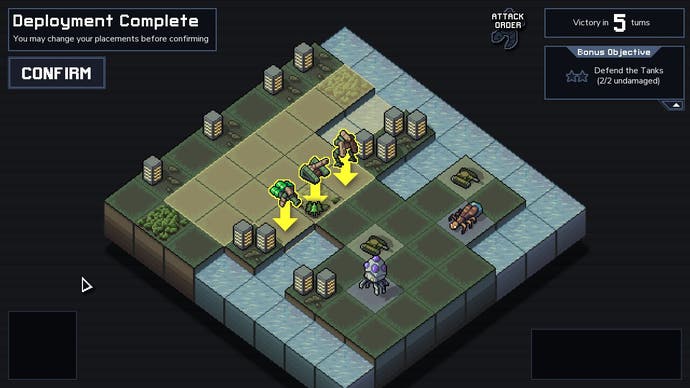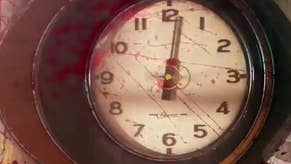Into the Breach review - tactical greatness in glorious miniature
What lies beneath.
Considering that Subset's last game, FTL, handed you an entire galaxy to knock about in, Into the Breach might strike you as being a little cramped in its opening minutes. This turn-based tactical battler likes to drop you into snug maps of eight squares by eight. You never have more than a handful of turns to worry about on each mission, and you have just three units to control as standard. What's worth remembering, though, is that FTL may have been set in the vast reaches of space, but it found its most frantic entertainment in the compact and claustrophobic arrangement of rooms that was your spaceship. This is a studio that understands panic and understands the power of confinement. FTL is a classic - and Into the Breach may well be even better.
The question with any turn-based tactical game is: what kind of game is this really? Once you take away the mechs and the super-soldiers, is this Chess again? Is it American Football? The easiest answer for Into the Breach - and it's not a complete answer because Into the Breach is not an easy game to get your head around - is that beneath a veneer that invokes the likes of Front Mission and even Advance Wars, this is billiards. By which I mean your shots matter, but victory lies in understanding where the remaining pieces are going to come to rest afterwards.
This is doubly true because so much of Into the Breach isn't merely concerned with blasting away at mutant hordes with your guns and missiles and lasers. It's concerned with doing all that while shoving them too. Shoving them into the sea where they drown. Shoving them onto a dangerous tile that is about to drop into the earth or be hit by falling magma or be engulfed with the burning fumes from a rocket launch. Missiles and lasers and guns are great, but you learn to look through the weapons you're given along the course of an adventure and cherish the ones that have drag or knockback powers. Again: it's not how much damage you do in a round, it's what the board looks like once the round is finished.

And here's something else. Into the Breach is also Whack-a-Mole. Your team of three units may drop from the sky into a deployment zone at the start of each mission - man, you can mess things up terribly badly by misjudging the deployment zone - but your enemies spawn from the ground, and the spots where they spawn are highlighted in the turn before you emerge. What this means is that you can park on them and stop them from coming up. You take a point of damage for that, of course. Better still - and remember, this is billiards, right? - you can knock an enemy back onto a spawn tile and they'll block the enemy and they'll take the point of damage.
Cripes, Into the Breach is filled with this stuff. It is filled with synergy, which is why it can get so much tragic storytelling into a mission that's five turns long. Everything in the game ties into something else: this is true at the level of knockback damage and spawn tiles and it's true at the other end of the scale as you find out that each in-game achievement you earn, for example, grants you a coin that you can spend on unlocking new loadouts of units.
All of this works because Into the Breach is a game of total information. You know how much damage an enemy is going to do and you can get a clear sense of what attack it's about to make. You know how far you can move at any time and what your own attack options are. On top of this, Into the Breach is one of those magical games where you're trying not to lose as much as you're trying to win. And there are so many ways to lose! Each mission you're dropped into will have its own subset of mini-objectives - protect a train, defeat a certain number of enemies, keep a particularly tricky enemy alive - that will give you a specific reward. But there's also the wider objective: survive until the turns you're given have run out.
And survival is complicated. You can lose your units - and any pilots controlling them will die and permanently take their perks with them - or you can allow too much damage to befall the little tower blocks that are scattered around each level. Tower blocks power the grid, which is basically the health meter of the specific island campaign you're fighting at present, each one having their own clusters of missions and their own quirks, from deserts that offer up dust storms to coasts with tidal waves that eat away at the land and a cybernetic island where you're not just fighting the mutant beasts but some rogue AIs too.

Out of this spirals a gloriously ordered campaign, absolutely filled with difficult choices. You will never be able to do all the things you want to. At the simplest level of things, you must complete a series of missions before a climactic battle at the island's HQ, and while you select your missions you're trading off the difficulty posed by it and the rewards it offers: reputation points that can be spent at the end-of-island shop to buy new weapons and gadgets, energy that can restore power bars to the island's grid, reactor cores that power up your units, bringing extra weapons online perhaps or raising their health and movement capabilities. You can win an island campaign but emerge so battered and so lacking in resources that your hopes for the next island are pretty much scuppered. And when you get to the next island, the whole thing repeats, and then, once you've liberated two of the four islands, you can decide to take on the multi-stage final mission - or you can risk everything on tackling another island or two in the hopes that it will leave you better prepared.
Throw in a handful of simple but satisfying enemy types: lobbers, earth-quakers, psionic brains that give everyone on their side a boost. Throw in weapons that allow you to flip enemy attack directions, that laser through multiple targets and leave flames or ice in their wakes. Throw in those pilots that come with their own perks and can be levelled up or lost in a single mistake. Throw in those different friendly units that play in entirely distinct ways, one group specialising in stirring up lighting storms, another that seems to receive as much damage as it deals out when it's fighting.
And pretty soon you're lost in the detailing and you realise that - yes! - alongside being billiards and Whack-a-Mole and chess and American Football and all the rest of it, Into the Breach is also FTL, in its delight in the glinting clockwork of failure, in its fascination with difficult choices, in surprising victories, in drastic variation that works its strange magic within tight restrictions. And all of these games come together to make Into the Breach, which is precise and brutal and complex and dizzying and utterly thrilling - and Into the Breach is, somehow, entirely its own thing too.













